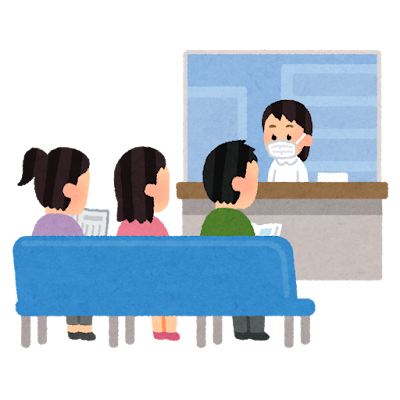腎臓内科における急性・慢性腎不全に関する会話例と英語フレーズ
**急性腎不全(Acute Renal Failure)と慢性腎不全(Chronic Kidney Disease, CKD)**は、どちらも腎臓の機能が低下し、体内の老廃物や余分な水分を適切に排出できなくなる状態です。急性腎不全は突然発症するのに対し、慢性腎不全は時間をかけてゆっくりと進行します。
この記事では、これらの疾患に関する診察時の会話例と、英会話で役立つフレーズを学びます。
患者の設定
- 名前: Yoshiko Tanaka (70歳、女性)
- 職業: 退職者
- 主な症状: 疲労感、むくみ、食欲不振、尿の量が減少している。
- 既往歴: 高血圧、糖尿病
- 生活習慣: 運動不足、食事は塩分多め。
1. 初診での問診と症状の確認
会話例: 急性腎不全の疑いでの問診
Doctor: “Good morning, Ms. Tanaka. I understand you’ve been feeling fatigued and have noticed swelling in your legs. Have you also experienced a decrease in urination?”
日本語訳: 「おはようございます、田中さん。疲労感を感じ、脚のむくみに気づいたそうですね。尿の量が減っていることもありますか?」
Patient: “Yes, I’ve been feeling more tired than usual, and my legs are swollen, especially in the evening. I’ve also noticed that I’m not urinating as much.”
日本語訳: 「はい、最近はいつもより疲れやすく、特に夕方になると脚がむくんでいます。それに尿の量も減っているのに気づきました。」
2. 疾患の説明とリスク
会話例: 急性腎不全の説明
Doctor: “It’s possible that you have acute renal failure, which means your kidneys aren’t filtering waste from your blood properly. This can happen suddenly and may be caused by factors like dehydration, infection, or medication. We’ll need to run some tests to confirm the diagnosis.”
日本語訳: 「急性腎不全の可能性があります。これは、腎臓が血液から老廃物を適切にろ過できていない状態です。これは突然発症することがあり、脱水や感染症、薬の副作用などが原因となることがあります。診断を確認するためにいくつかの検査を行います。」
Patient: “Is it serious? Can my kidneys recover?”
日本語訳: 「それは深刻ですか?腎臓は回復しますか?」
Doctor: “Acute renal failure can be serious, but in many cases, if treated early, the kidneys can recover. We’ll need to identify the underlying cause and start treatment as soon as possible.”
日本語訳: 「急性腎不全は深刻なこともありますが、早期に治療を開始すれば、腎臓は回復することが多いです。原因を特定し、できるだけ早く治療を開始しましょう。」
会話例: 慢性腎不全(CKD)の説明
Doctor: “You may also have chronic kidney disease, which means your kidneys have been slowly losing function over time. This is often caused by long-term conditions like high blood pressure or diabetes. While chronic kidney disease can’t be cured, we can slow its progression with treatment.”
日本語訳: 「また、慢性腎不全(CKD)の可能性もあります。これは、腎臓の機能が時間をかけて徐々に低下している状態です。これは多くの場合、高血圧や糖尿病などの長期間続く病気によって引き起こされます。慢性腎不全は治癒できませんが、治療によって進行を遅らせることが可能です。」
Patient: “Is there anything I can do to prevent my kidneys from getting worse?”
日本語訳: 「腎臓がさらに悪化しないようにするために、私にできることはありますか?」
Doctor: “Yes, it’s important to control your blood pressure and blood sugar levels. Reducing salt intake, eating a kidney-friendly diet, and staying hydrated can also help. We’ll work together to monitor your kidney function and adjust your treatment as needed.”
日本語訳: 「はい、血圧と血糖値の管理が重要です。また、塩分摂取を減らし、腎臓に優しい食事を取り、適度な水分補給を行うことも役立ちます。今後も一緒に腎機能を監視し、必要に応じて治療を調整していきましょう。」
3. 検査と診断
会話例: 血液検査と腎機能検査の説明
Doctor: “To understand how well your kidneys are functioning, we’ll need to do a blood test to measure your creatinine and blood urea nitrogen (BUN) levels. These tests will tell us if your kidneys are filtering waste effectively. We’ll also perform a urine test to check for protein, which can be a sign of kidney damage.”
日本語訳: 「腎臓がどれくらい機能しているかを理解するために、血液検査でクレアチニンや血中尿素窒素(BUN)のレベルを測定します。これらの検査により、腎臓が老廃物を適切にろ過しているかどうかがわかります。さらに、尿検査を行い、タンパク質が含まれていないか確認します。」
Patient: “Will these tests show if I have kidney failure?”
日本語訳: 「これらの検査で、腎不全かどうかわかりますか?」
Doctor: “Yes, the blood and urine tests will give us a clear picture of how well your kidneys are working. If the results show signs of kidney failure, we’ll discuss the best treatment options to manage your condition.”
日本語訳: 「はい、血液検査と尿検査で、腎臓がどれくらい機能しているかが明確にわかります。検査結果に腎不全の兆候があれば、最適な治療法についてお話しします。」
4. 診断結果と治療法の説明
会話例: 急性腎不全の治療法の説明
Doctor: “If the tests confirm acute renal failure, we’ll start treatment immediately. This may include intravenous fluids to rehydrate you, medications to manage your blood pressure, and stopping any medications that may be harming your kidneys.”
日本語訳: 「検査で急性腎不全が確認された場合、すぐに治療を開始します。これには、点滴で水分補給を行い、血圧を管理する薬を使用し、腎臓に負担をかけている可能性のある薬を中止することが含まれます。」
Patient: “Will my kidneys recover completely?”
日本語訳: 「腎臓は完全に回復しますか?」
Doctor: “In many cases, if treated early, the kidneys can recover their function. However, it’s important to follow up regularly to monitor your recovery and prevent any further damage.”
日本語訳: 「多くの場合、早期に治療を開始すれば、腎臓の機能は回復します。しかし、定期的なフォローアップで回復を監視し、さらなる損傷を防ぐことが重要です。」
会話例: 慢性腎不全の治療法の説明
Doctor: “For chronic kidney disease, the main goal of treatment is to slow down the progression of the disease. This includes controlling your blood pressure and blood sugar levels, reducing salt intake, and possibly taking medications to protect your kidneys. In advanced stages, dialysis or a kidney transplant may be necessary.”
日本語訳: 「慢性腎不全の治療の主な目標は、病気の進行を遅らせることです。これには、血圧と血糖値の管理、塩分摂取の減少、そして腎臓を守るための薬を服用することが含まれます。進行期には、透析や腎移植が必要になる場合もあります。」
Patient: “Will I eventually need dialysis?”
日本語訳: 「最終的に透析が必要になりますか?」
Doctor: “It depends on how well we can control your kidney disease with treatment. Some patients never need dialysis, while others may require it if their kidney function declines significantly. We’ll monitor your condition closely and adjust your treatment as needed.”
日本語訳: 「治療によって腎臓病をどれだけ管理できるかによります。透析が必要ない患者さんもいれば、腎機能が著しく低下した場合に透析が必要になる方もいます。状態を慎重に監視し、必要に応じて治療を調整します。」
5. 生活習慣とフォローアップ
会話例: 慢性腎不全の生活習慣のアドバイス
Doctor: “In addition to medications, making lifestyle changes is crucial for managing your kidney disease. Reducing your salt intake, following a kidney-friendly diet, and staying hydrated are important steps. We’ll also recommend regular check-ups to monitor your kidney function and adjust your treatment as needed.”
日本語訳: 「薬物療法に加えて、生活習慣の改善は、腎臓病を管理するために非常に重要です。塩分摂取を減らし、腎臓に優しい食事をとり、適度な水分補給を行うことが大切です。また、定期的な検査で腎機能を監視し、必要に応じて治療を調整します。」
Patient: “I’ve been trying to follow a low-sodium diet, but it’s difficult. Are there specific foods I should avoid?”
日本語訳: 「塩分を抑えた食事を心がけているのですが、難しいです。避けるべき特定の食べ物はありますか?」
Doctor: “Yes, try to avoid processed foods like canned soups, salty snacks, and fast food. Instead, focus on fresh vegetables, fruits, and low-sodium options. We can also refer you to a dietitian to help you create a kidney-friendly meal plan.”
日本語訳: 「はい、缶詰スープや塩辛いスナック、ファストフードなどの加工食品は避けるようにしましょう。代わりに、新鮮な野菜や果物、低ナトリウム食品を選ぶようにしてください。腎臓に優しい食事プランを作るために、栄養士を紹介することもできます。」
学習ポイント
- 症状の確認: 急性腎不全と慢性腎不全に関連する症状を確認するためのフレーズを学びます。例: “Have you noticed any swelling in your legs or a decrease in urination?“(脚のむくみや尿の量の減少に気づきましたか?)
- 検査の説明: 腎不全の診断に必要な検査を説明するフレーズを学びます。例: “We’ll perform blood and urine tests to check your kidney function and see if there’s any damage.“(腎機能を確認し、損傷があるかどうか調べるために、血液検査と尿検査を行います。)
- 治療法の説明: 急性・慢性腎不全の治療法を説明するフレーズを学びます。例: “The goal of treatment is to slow the progression of kidney disease and protect your kidney function.“(治療の目標は、腎臓病の進行を遅らせ、腎機能を保護することです。)
- 生活習慣のアドバイス: 腎臓を健康に保つための生活習慣についての表現を学びます。例: “Reducing salt intake and maintaining good hydration are important for protecting your kidneys.“(塩分摂取を減らし、適度な水分補給を行うことが、腎臓を守るために重要です。)
関連キーワード: 急性腎不全, 慢性腎不全, CKD, 腎機能検査, 血液検査, 塩分制限, 血圧管理, 英語会話例, 外国人対応




